Aug 8 2017
Tuesday – a tough 4x1km on the water
[amazon_link asins=’0544947223′ template=’ProductAd’ store=’rowingdata-20′ marketplace=’US’ link_id=’bed92e4b-7c3e-11e7-bf61-c376ad7ff20a’]
I am reading the book “Peak” by Ericsson and Pool. Interesting stuff. They talk about “deliberate practice”. In summary, deliberate practice involves practicing with well-defined, specific goals, getting constant feedback, and constantly moving a little outside your comfort zone to avoid stagnation.
I think that having a power meter makes it a lot easier to implement “deliberate practice” in rowing.
So for Monday, the training schedule asked for the good old “Pete Plan” classic: The 4x1km at 5 minutes rest. On the erg, I haven’t done this one in a long time. The last one was in September 2015. On the water, I have done a few. Here’s a summary:
So, OTW, should I aim for 2:01 pace? Really, this depends a lot on the weather. Now that I have a power meter, I should really row these workouts to a power target. So, I looked at my CP Chart. A 1k should take me around 4 minutes, roughly, but I was going to do four of them. On the other hand, there was going to be a 5 minute rest period between the 1k efforts. Now, the CP chart tells me that on the water, I should be able to hold 345W for 4 minutes, and 250W for 16 minutes. I “guesstimated” that I should aim for a value in the middle: 300W. I also wanted to row at Work per Stroke (“WpS”) values below 600J. The hypothesis is that this is the most efficient Work per Stroke value for my rowing.
That fixes the stroke rate to 30spm and higher. So, the targets were clear. Now, the execution.
There was some wind when I arrived at the rowing club, and the wind was increasing in strength. During the warming up, I quickly decided to do the 4x1k in the gorge, because if the wind would get any stronger, I would be testing my rough water skills rather than my fitness and rowing efficiency.
Then, it was time to start the series of 1000m intervals. The straightest part of the gorge is about 900m long, and with a slight turn at the end you can call it a 1k effort. The wind would be a straight tailwind and headwind, for the alternating intervals. My first interval was a tailwind one, towards the castle.
As in the previous OTW versions of this workout, I would do all intervals from a static start. I started the first interval way above target power, stroke rate and WpS and had to work hard to reduce them. The average WpS was 614 J, and the interval did get make me tired.
A 5 minute paddle, 2 minutes towards the castle, 30 seconds to turn and drink, 2 minutes back, 30 seconds to align for the start. This time it was a bit easier to hit the WpS values, but about 100m in I was in trouble. I heard a hissing sound right next to my boat, and when I looked, I saw a very angry parent swan and four young swans. I ignored the swans and carried on. Luckily, the swan decided not to charge. Then, 300m into the row, I was in trouble. Deep trouble, that I could not row away from. Pain. Hard breathing. The feeling that this was not a sustainable pace. With 400m to go I had to start counting strokes, and I somehow managed to make it to the end. WpS: 570 J.
In the third, tailwind interval, I decided to ignore the tiredness and rate up. My time equalled that of the first 1k, but I rowed this one at a WpS of 557 J. I also think that the wind was helping me a bit more than in the first interval.
For the last interval, I carefully lined up as far from the swan family as possible, which would make me row a bit more of the turn at the end of the 1k, and started. My suspicions about the wind strength were confirmed immediately as I settled down for 32spm.
I wasn’t able to hold 32spm. I somehow made it to half way rowing slightly under target, power wise, but at that point I had a very serious fight with the “handle down daemons”. If I wouldn’t be a blog writing rower who was rowing to meet a clear target for this session, I doubt if I would have completed this interval. I did dial down the power though, and only in the last 10 strokes did I rate up and power up a bit. I wish I could say that the power drop in this interval is due to the turn in the end, but I am afraid that that is only partly true. Still, kudos to myself for finishing the session. What did I write above about comfort zone? WpS result: 518 J.
Work Details
#-|SDist|-Split-|-SPace-|-SPM-|-Pwr-|AvgHR|MaxHR|DPS-
01|01000| 03:53 |01:56.8| 30.0| 311 | 170 | 180 | 8.5
03|01000| 04:12 |02:06.3| 30.9| 294 | 174 | 182 | 7.7
05|01000| 03:53 |01:56.9| 31.8| 296 | 171 | 180 | 8.1
07|01000| 04:20 |02:10.3| 30.9| 270 | 172 | 179 | 7.5
So in the end, I managed 293W. Slightly below target, and a good starting point for the next time. Comparing that to the erg, I think it is a good score. The 1k on the erg lasts 30 to 50 seconds shorter than the OTW 1k. Also, the OTW and OTE power values do not correspond 1:1, and it is usually estimated that they are about 15% lower OTW. For my analysis, I use 6%, so the erg equivalent is doing 4x4min/5min at 1:44 pace.
A good starting point for the next time.
Here are a few plots that tell the story:
The cooling down was a slow affair in a heavy headwind and significant waves:
I used rowsandall.com’s Physics Department to do an estimate of wind corrected pace. I used 1.5 m/s as the wind speed. At that time, Brno airport reported 7.7 m/s, and the wind prediction for the Brno lake was increasing from 2 m/s to 4 m/s at that time. But I was in the relatively shielded gorge. Here is the result:
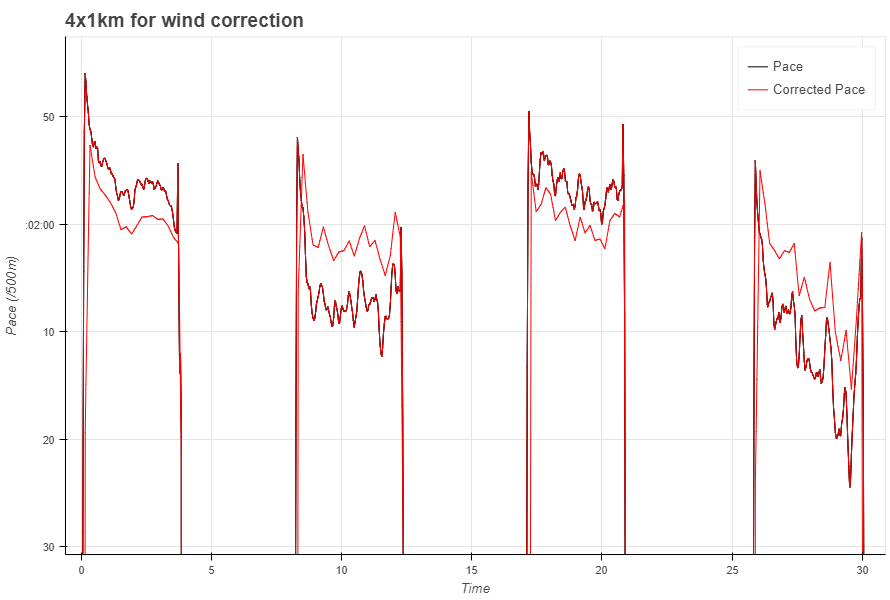
So in the end the data for the first three intervals seem to hover around 2:00 pace, perhaps even slightly faster if I assume that the wind was increasing. I hope so, because I was really depressed by the slow average pace.
The last interval is still dramatically slow.
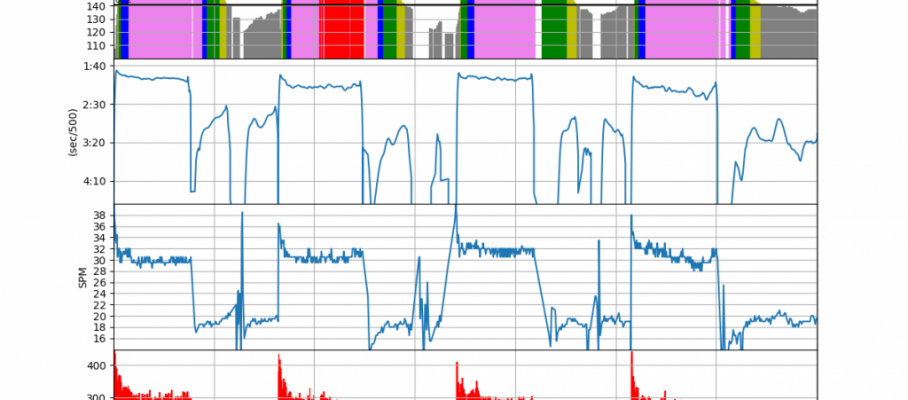

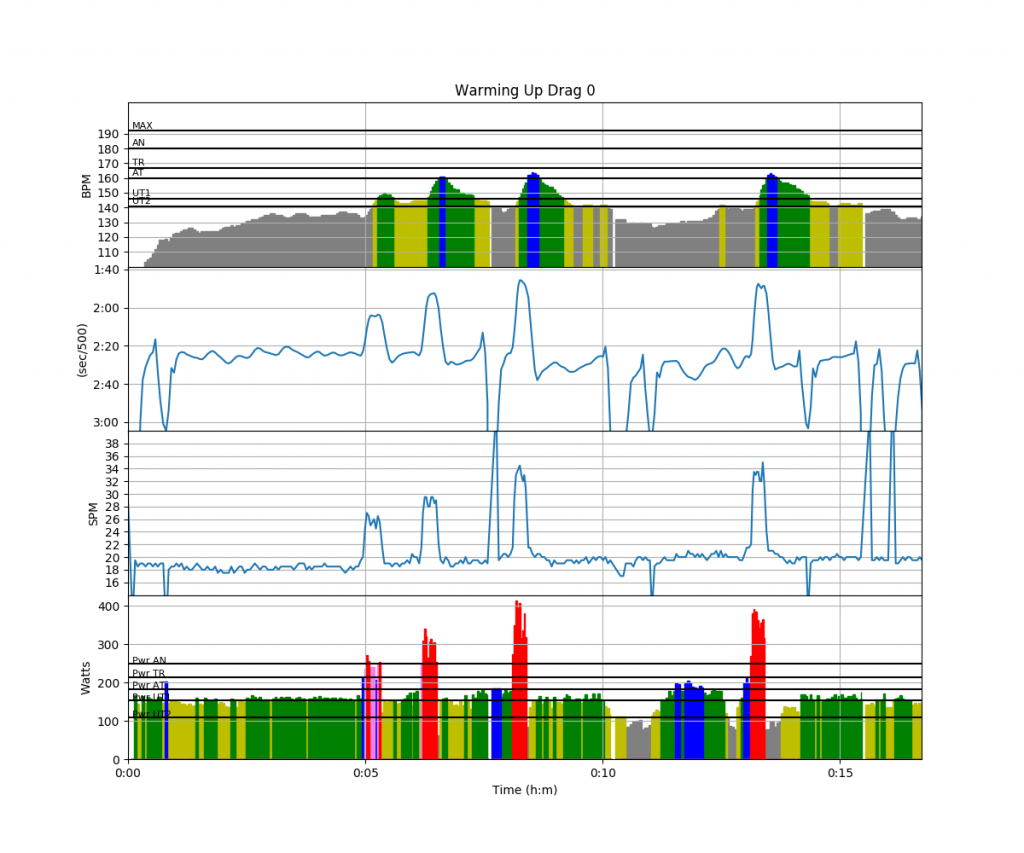
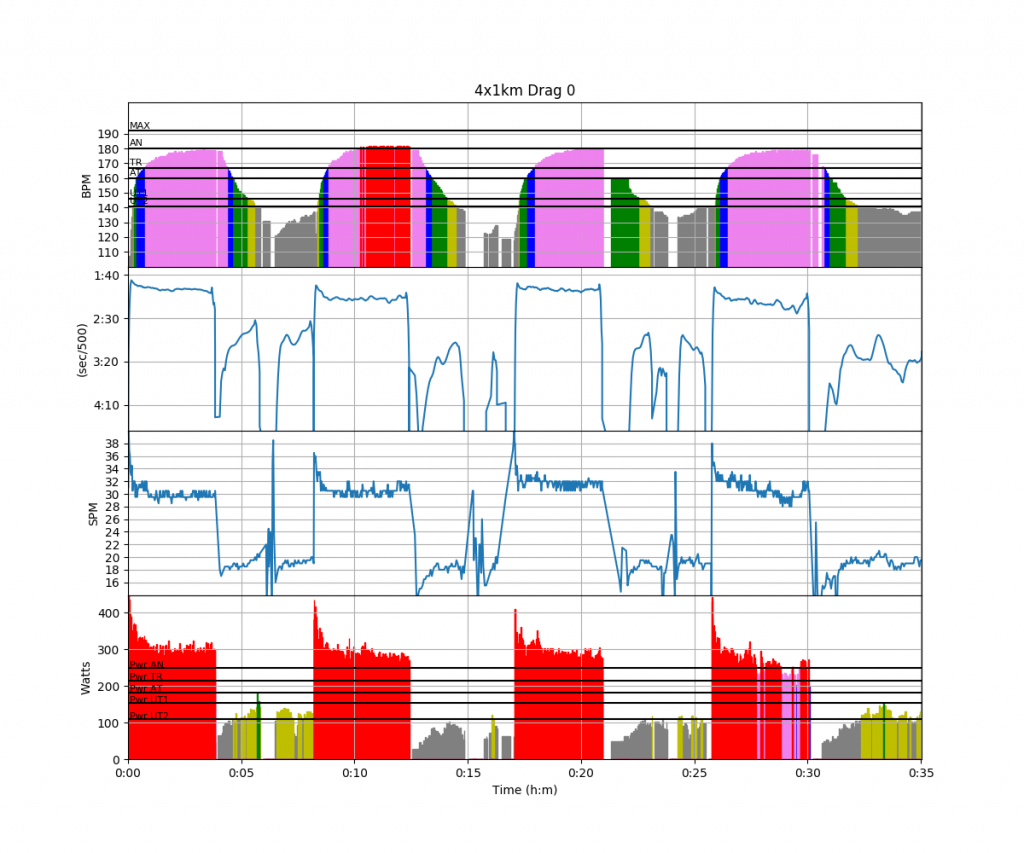
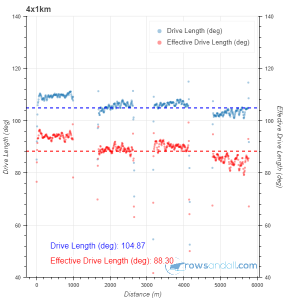
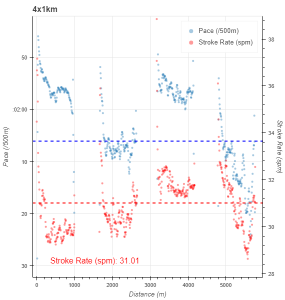
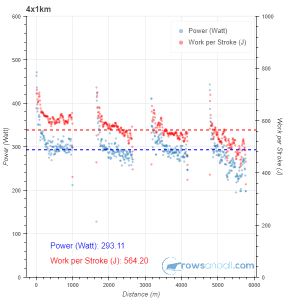
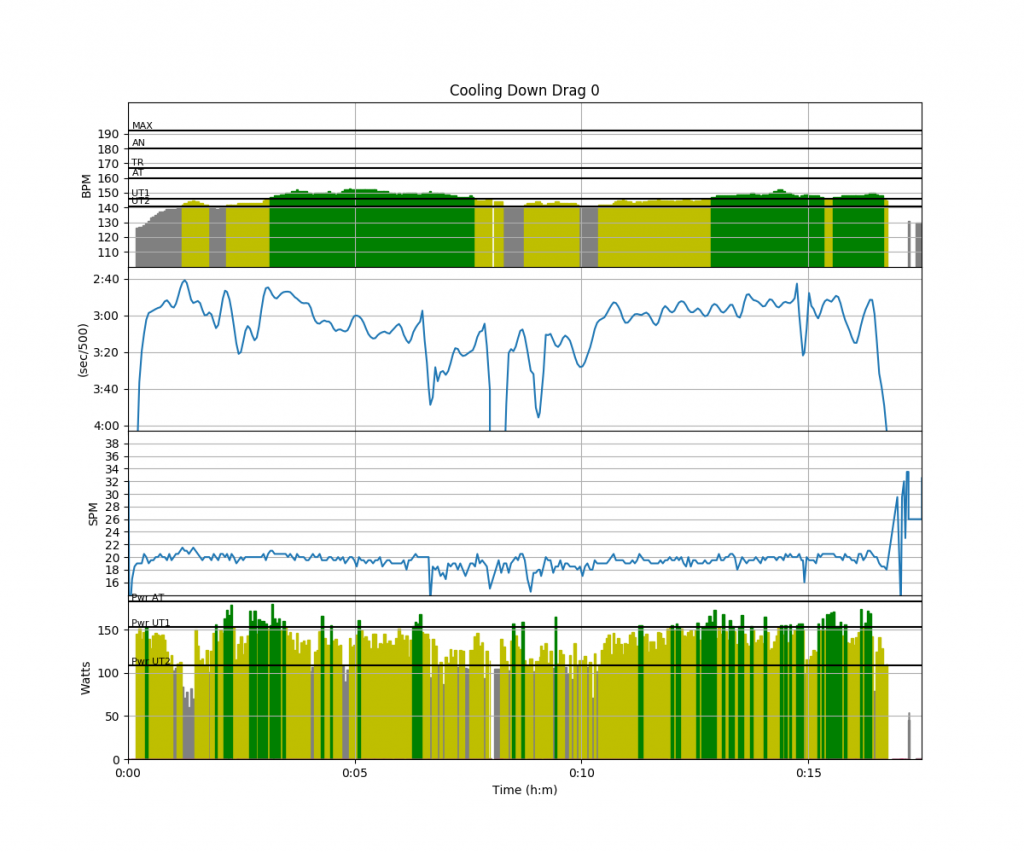
Aug 14 2017
Monday: 4x1km/5min – 16 minutes of pain
I didn’t do my weekend homework – so I had to get to work early and do it in the morning. Visits from the US and I got to play my boss. It all went very well, except that the A/C broke down in our building and it was 28 degrees in the meeting room. We should have moved to the patio, where it was just 26 degrees.
So after a long day I waved goodbye to my guests and headed to the rowing club. I was going to do a 4x1km and tried to get some of the Masters crews to row it alongside me, but nobody fancied this training. I don’t blame them. It is quite hard. But I am doing a mini cycle with threshold training and intensive distance, hoping it will move my anaerobic threshold a bit, which should help me at the Masters Worlds, if I manage to convert that to boat speed.
That’s the theory. Besides that, the 4x1km is just a hell of a session. The big advantage of rowing with a power meter is that you can take the average power of the last time as a target, and then try to improve. There is still a weather influence. It will be harder in choppy conditions, but it is still a lot more quantitative than trying to row to feel or a target pace.
I was tired and worried that I would have low grit to complete the session, but everything turned out better than expected. The target power was a bit lower than the first three intervals of last week (because the overall average was lowered by a dramatically slow fourth interval), so it was tough but doable, and I was able to focus on technique as well.
A slight additional difficulty was the fact that the place I chose to row the workout brought me in near collision course with big tourist boats on all intervals except the first one. In the second interval I managed to cross in front. In third and fourth interval I had to row through the wake. That explains short drops in power.
Interesting that my heart rate graph shows more red in the third interval. The fourth one was definitely a harder one.
Work Details
#-|SDist|-Split-|-SPace-|-SPM-|-Pwr-|AvgHR|MaxHR|DPS-
01|01000| 04:12 |02:06.2| 29.2| 293 | 169 | 180 | 8.1 - headwind
03|01000| 03:58 |01:59.0| 30.5| 294 | 173 | 181 | 8.3 - tailwind
05|01000| 04:08 |02:04.4| 30.6| 292 | 173 | 182 | 7.9 - headwind
07|01000| 03:57 |01:58.5| 31.1| 296 | 172 | 183 | 8.1 - tailwind
I set average pace on the lower right of my SpeedCoach and rowed this like an ergo training. Static start. Off you go, a few start strokes, then drop the pace immediately. Row slightly under the target until the average power hits target, then keep holding target power.
Here are the metrics charts. I include all of my regular ones this time. You can click on one of them to see a bigger version and then browse through the image gallery. The point I am trying to make is that it looks like pretty consistent rowing.
I am still fascinated by the trend flex charts. Here is this row, pace vs power, split by stroke rate:
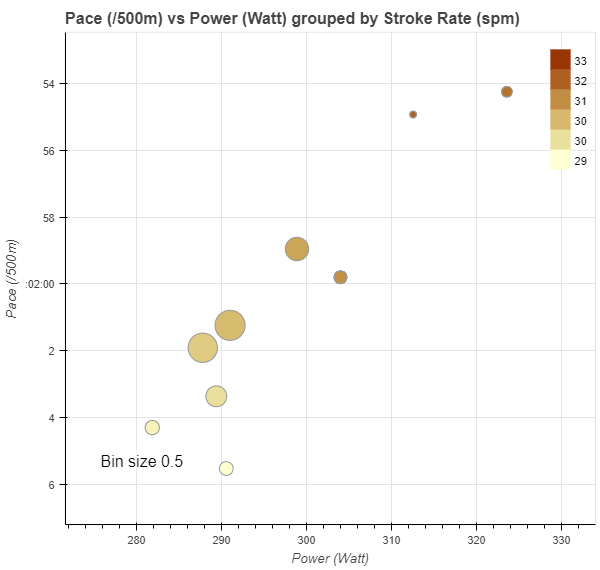 For comparison, here is the power/pace behavior with every individual workout stroke:
For comparison, here is the power/pace behavior with every individual workout stroke:
Most of those high stroke rate strokes are from the final 250m in the final interval:
Those 250m really really hurt. I think I haven’t been that deep in the pain box in training, recently. Again, that is the power of training with a power meter. Having a target and wanting to improve is what really kept me going.
I improved by 1 Watt. One tiny Watt. In terms of energy expended, that is 1/200th of an Apple. The progress is that the way I rowed it, it felt easier.
By sanderroosendaal • Uncategorized • 0 • Tags: 4x1k, 4x1km, intervals, lake, OTW, rowing, single, threshold, training